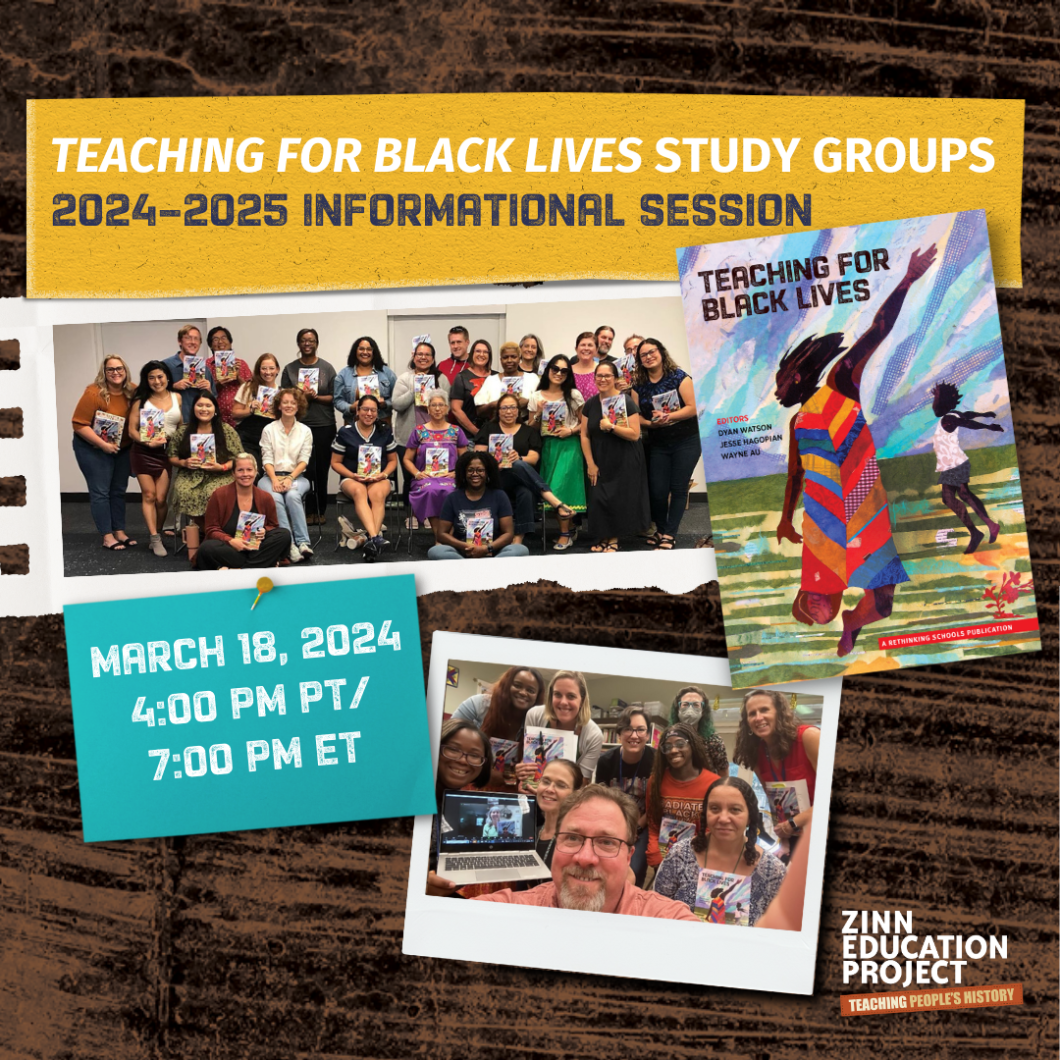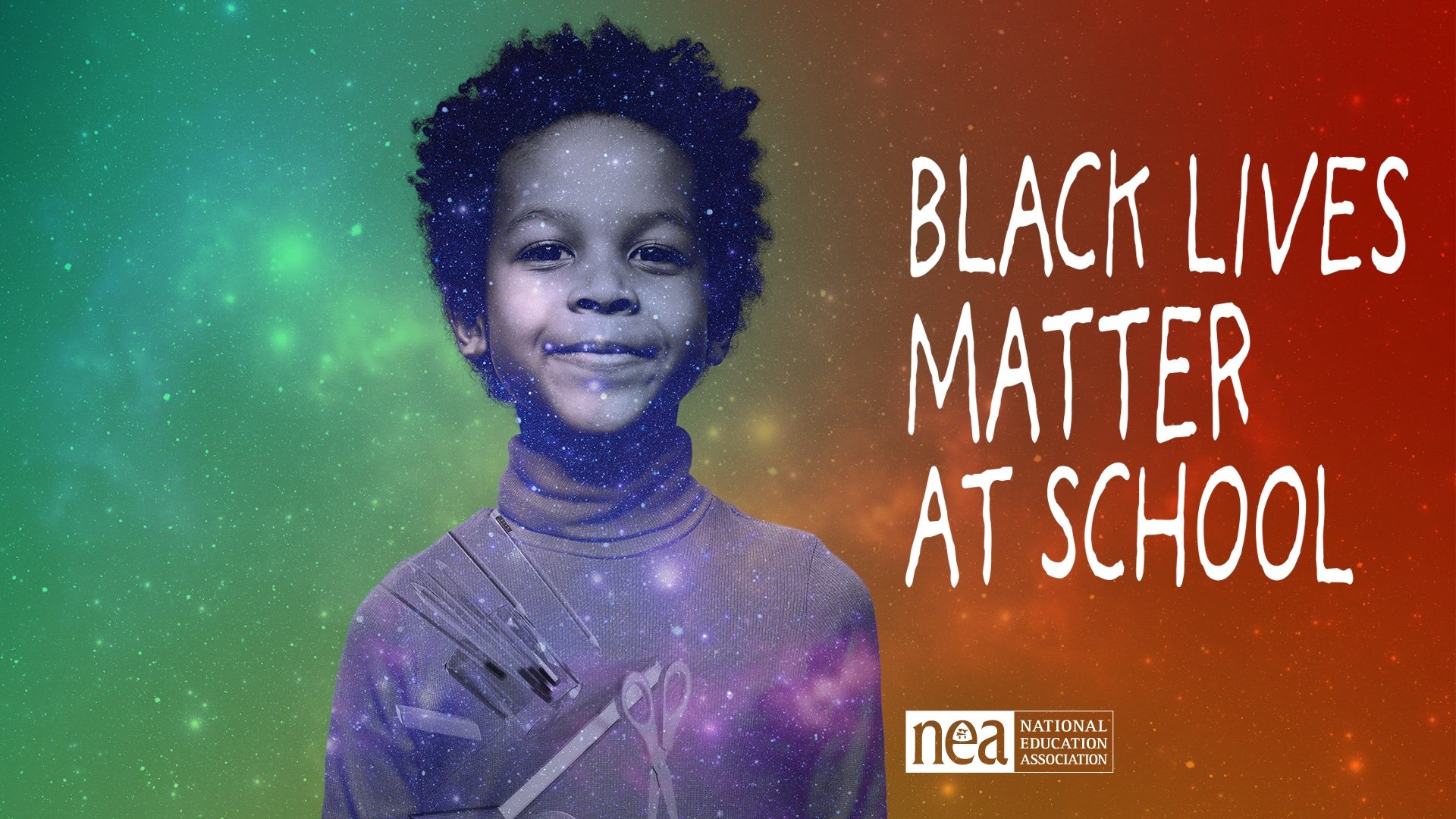2024 National Black Lives Matter at School Week of Action
We’re amplifying National Black Lives Matter at School’s call for a Year of Purpose. Take one action a day between February 5-9 to join the movement.

Teaching for Black Lives Study Groups
Each year the Zinn Education Project hosts Teaching for Black Lives study groups across the United States. Using the Rethinking Schools book Teaching for Black Lives, educators explore how to teach about racism, resistance, and joy in free, teacher-led professional learning communities. Check out this three-minute video on the Teaching for Black Lives campaign.

The Zinn Education Project is offering an informational session for educators who are interested in forming a Teaching for Black Lives study group in the 2024–2025 school year. Participants will hear from previous and current study group coordinators about their experience and impact. The session will include time to ask questions at the end.
The Zinn Education Project supports at least 100 Teaching for Black Lives study groups each school year. This is a free professional learning opportunity. Each group receives:
- Teaching for Black Lives book for each participant (up to 20), study questions, and a meeting facilitation guide
- Rethinking Schools magazine subscription for each participant (up to 20)
- Introductory workshop featuring one or more editors of Teaching for Black Lives
- Access to several invitation-only webinars and workshops (panel discussions on current events, curriculum workshops, campaign planning)
- Closing event featuring one or more special guests
- Access to a network of other study groups and social justice educators across the United States
- Dedicated administrative support for study group coordinators
NEA’s Black Lives Matter @ School Demands
Our children hold the dreams of future generations, and by joining together - parents and teachers, Black, white, and brown - we can make our schools and communities places where all children can learn, grow, and thrive.
To continue the ongoing movement of critical reflection and honest conversation and impactful actions in school communities we will work together to:
1. Create supportive environments where all students can learn, grow, and thrive
School is a place where childhood happens. Most of us believe that every child, whatever their color, background or zip code, has the right to learn in a supportive environment that respects their humanity, upholds their dignity, and responds fairly to mistakes and mis-steps.
Our neighborhood public schools should be places where children can ask questions, make mistakes, and learn so they can live fulfilling lives .Every student has a right to a quality education, to be treated with dignity, and to be provided with the opportunity to learn.
But today, certain politicians fuel divisions so they can take resources away from our schools while they let the wealthiest few get away with not paying their fair share. They then blame parents, teachers and students to distract from these failures. They enact zero tolerance and other exclusionary school discipline policies that push Black, brown and LGBTQ+ students out of the classroom and into the criminal justice system —harming our students, our educators, and our communities.
Effective approaches to discipline include restorative justice practices that can result in improved school climates and increased educational opportunities.
We will support and implement policies that will:
- End suspensions and arrests for minor misbehavior.
- Adopt school-wide positive restorative justice practices and enhance training for all school personnel.
- Engage educators, students, parents, and community advocates to build and strengthen successful implementation.
When we join together across race and place, we can demand that our schools treat all our children equitably and with compassion, nurturing a love of learning and meeting childhood mistakes with the proven approaches that help kids grow.
Resources

Do Restorative Practices Work?

Let Her Learn

Dignity in Schools Model Code
2. Empower Black Educators to Strengthen Our Schools
No matter what we look like, where we live, or what’s in our wallets, most of us want our public schools to inspire imagination, cultivate critical thinking, and ensure our children can live fulfilling lives. But certain politicians try to divide us, ensuring well-resourced schools with mostly white students have enrichment activities, teacher training, and parent engagement, while sending police to monitor and punish Black and brown students in schools that have been denied funding to even cover the basics. Then they turn around and point the finger at families of color for the challenges at our schools, while letting the wealthiest few refuse to pay their fair share. That’s why we are coming together to ensure every child, regardless of race, ability, or zip code, has a neighborhood school with well-prepared teachers, class sizes that enable one-on-one attention, nurses, counselors, and healthy meals that ensure they can thrive. Ensuring students have access to diverse faculty and staff reflective of the demographics of the community, country and world, provides significant value to Black, Indigenous and other People of Color (BIPOC) students, white students, educators, school staff, and administrators.
We demand Black educator and student voices be integral to the decisions that impact their schools and communities. Whether Black, Brown, Indigenous or white, when students, families and educators come together to ensure diverse educator voices in our public schools — from pre-K to higher education — the whole community is stronger.
By joining together across race and place, we can rewrite the rules to increase recruitment and retention of educators of color, ensure that leadership opportunities are offered in equitable ways to create diverse education leadership teams at every site and level of public education.
Resources

When Natural Hair Wins, Discrimination in School Loses

Art for Activism
3. Upholding the Freedom to Learn Black History and Ethnic Studies
Whatever our color, background, or zip code, we want our children to have an education that imparts honesty about who we are, integrity in how we treat others, and freedom to pursue our dreams. But for years, certain politicians have denied some children the resources needed for a quality education based on what they look like or where they live. Now those politicians want to censor the truth of our history, passing laws to ban learning from the mistakes of our past and erase leaders like Martin Luther King, Jr. who stood up to racism and changed our country for the better.
Studies show that students enrolled in Black and ethnic studies courses that include the experiences and narratives of Black, Indigenous and other People of Color (BIPOC) and LGBTQ people, honor their cultural assets, and provide students with tools to critique inequality, develop strong relationships with teachers and gain benefits in terms of school engagement and persistence in academic attainment.
By joining together and speaking up at school board meetings, contacting our elected leaders, and voting to fully fund our schools, we can make this a country where every child has the freedom to learn, grow and thrive.
Resources

Recruiting Educators of Color

Honesty in Education model school board resolution

BLM@School Curriculum Guide
4. Supporting More Counselors, Coaching & Connections to Deliver Black Students’ Dreams
Most of us believe that every child, whatever their color, background or zip code, has the right to learn in a supportive environment that respects their humanity, upholds their dignity, and ensures just responses for mistakes and missteps.
But certain politicians have created color-coded barriers to equal education, denying schools in poorer communities the resources they need and sending in police to target, monitor and punish Black and brown students. We must move our money away from policing and arresting children and towards the proven solutions that set our kids up for fulfilling lives.
Decision makers at all levels must re-examine the role of law enforcement in our communities and our public schools to ensure public safety, while dismantling unjust policies designed to disproportionately impact Black and Brown people, such as mass incarceration, militarization of law enforcement, unlawful separation and detention of immigrant children and families and the excessive use of force.
Black lives matter, and we can ensure the safety and wellbeing of all our families by funding our schools with the community services, health care, and the supports we need.
We are coming together to demand that liberty and justice be for all by moving our money to the services and supports we need and away from the policing that hurts our communities.
Resources
Making Schools Safe and Just

ACLU: Cops and No Counselors

BLM@School Pledge
Learn More
Join Our Movement




